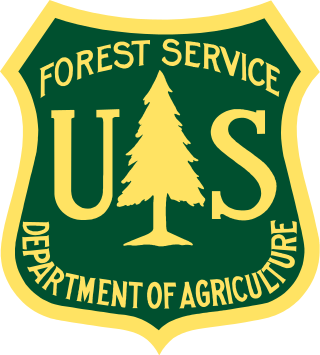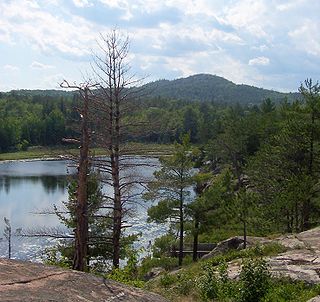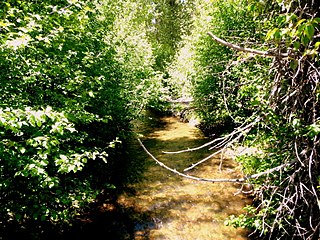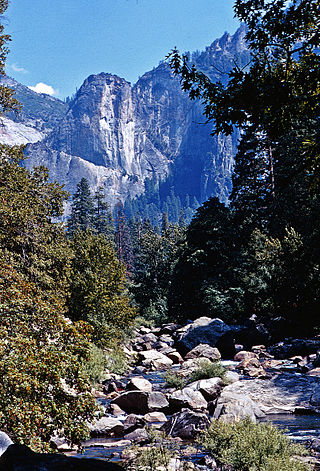Related Research Articles

The United States Forest Service (USFS) is an agency within the U.S. Department of Agriculture that administers the nation's 154 national forests and 20 national grasslands covering 193 million acres (780,000 km2) of land. The major divisions of the agency are the Chief's Office, National Forest System, State and Private Forestry, Business Operations, as well as Research and Development. The agency manages about 25% of federal lands and is the sole major national land management agency not part of the U.S. Department of the Interior.

Aldo Leopold was an American writer, philosopher, naturalist, scientist, ecologist, forester, conservationist, and environmentalist. He was a professor at the University of Wisconsin and is best known for his book A Sand County Almanac (1949), which has been translated into fourteen languages and has sold more than two million copies.

The Huron–Manistee National Forests are two separate national forests, the Huron National Forest and the Manistee National Forest, combined in 1945 for administration purposes and which comprise 978,906 acres (3,960 km2) of public lands, including 5,786 acres (23 km2) of wetlands, extending across the northern lower peninsula of Michigan. The Huron–Manistee National Forests provide recreation opportunities for visitors, habitat for fish and wildlife, and resources for local industry. The headquarters for the forests is in Cadillac, Michigan.

The Huron Mountains are located in the Upper Peninsula of the U.S. state of Michigan, mostly in Marquette County, and extending into Baraga County, overlooking Lake Superior. Their highest peak is Mount Arvon, which is the highest point in Michigan at 1,979 feet (603 m) above sea level. Nearby Mount Curwood, Michigan's second highest mountain at 1,978 feet (603 m), is also a part of the Huron Mountains.
The protected areas of Michigan come in an array of different types and levels of protection. Michigan has five units of the National Park Service system. There are 14 federal wilderness areas; the majority of these are also tribal-designated wildernesses. It has one of the largest state forest systems as well having four national forests. The state maintains a large state park system and there are also regional parks, and county, township and city parks. Still other parks on land and in the Great Lakes are maintained by other governmental bodies. Private protected areas also exist in the state, mainly lands owned by land conservancies.
Bartram Forest Wildlife Management Area is a 2,113-acre (9 km2) state land tract in Baldwin County and Wilkinson County, Georgia, United States. The forest was named in honor of naturalists John Bartram (1699-1777) and his son William Bartram (1739-1823).

Yale School of the Environment (YSE) is a professional school of Yale University. It was founded to train foresters, and now trains environmental students through four 2-year degree programs, two 10-month mid-career programs, and a 5-year PhD program. Still offering forestry instruction, the school has the oldest graduate forestry program in the United States.

Detroit Island is an island in Lake Michigan in the southern part of the town of Washington in Door County, Wisconsin, United States. The island has a land area of 2.578 km², out of which 27.6% is open to the public. The northern end of the island borders the waters of Detroit Harbor.

Aldo Starker Leopold was an American author, forester, zoologist and conservationist. He also served as professor at the University of California, Berkeley for thirty years. Throughout his life, Leopold was active in numerous wildlife and conservation groups throughout the United States. Leopold later defended his ideas of Land ethic which was a new way to connect nature, land and people.

Sun Pass State Forest is one of six state forests managed by the Oregon Department of Forestry. The forest is located 40 miles (64 km) north of Klamath Falls, Oregon near the southeastern corner of Crater Lake National Park. It is the largest single block of Oregon state forestry land east of the Cascade Mountains. The forest is managed as part of the Klamath-Lake District, comprising 21,317 acres (8,627 ha) of the 33,739 state-owned acres within the district.

Santiam State Forest is one of six state forests managed by the Oregon Department of Forestry. The forest is located approximately 25 miles (40 km) southeast of Salem, Oregon, and includes 47,871 acres (193.73 km2) on the western slope of the Cascade Mountains in three Oregon counties: Clackamas, Linn, and Marion. It is bounded on the east by the Willamette National Forest and Mount Hood National Forest. Silver Falls State Park is located west of the forest. The rest of the land surrounding the forest belongs to the Bureau of Land Management or is privately owned. The forest is managed as part of the Department of Forestry's North Cascade District.

The Society of American Foresters (SAF) is a professional organization representing the forestry industry in the United States. Its mission statement declares that it seeks to "advance the science, education, and practice of forestry; to enhance the competency of its members; to establish professional excellence; and, to use the knowledge, skills and conservation ethic of the profession to ensure the continued health and use of forest ecosystems and the present and future availability of forest resources to benefit society". Its headquarters are located in Washington, D.C.

Conservation in the United States can be traced back to the 19th century with the formation of the first National Park. Conservation generally refers to the act of consciously and efficiently using land and/or its natural resources. This can be in the form of setting aside tracts of land for protection from hunting or urban development, or it can take the form of using less resources such as metal, water, or coal. Usually, this process of conservation occurs through or after legislation on local or national levels is passed.
The New York State College of Forestry, the first professional school of forestry in North America, opened its doors at Cornell University, in Ithaca, New York, in the autumn of 1898., It was advocated for by Governor Frank S. Black, but after just a few years of operation, it was defunded in 1903, by Governor Benjamin B. Odell in response to public outcry over the College's controversial forestry practices in the Adirondacks.
Menominee River State Recreation Area is a state-managed protected area located in Breitung and Norway townships in Dickinson County and Faithorn Township in Menominee County, Michigan, southeast of Iron Mountain. It is 2,354 acres (953 ha) in area and is currently undeveloped. The park comprises a 145.35-acre (58.82 ha) tract along 1.5 miles (2.4 km) of the Menominee River south of the City of Norway and the 2,208.83-acre (893.88 ha) Quiver Falls Tract along eight miles (13 km) of the river farther downstream. In 2016, an additional 525-acre (212 ha) of Escanaba State Forest land was transferred from the Forestry Division to the DNR's Parks and Recreation Division and became the Pemene Falls Unit of the park, matching a similarly named unit on the Wisconsin side of the river.

Herbert L. Stoddard was an American naturalist, conservationist, forester, wildlife biologist, ecologist, ornithologist, taxidermist, and author. In the 20th century he earned a reputation for being one of the American Southeast's most prominent conservationists and a pioneering forest ecologist. He is most well known for his seminal book, The Bobwhite Quail: Its habits, preservation, and increase (1931). He is also widely credited with advocating for the practice of prescribed fire as a tool for wildlife management. He was married to Ada Wechselberg, with whom he had one son, Herbert "Sonny" L. Stoddard Jr.

Edward Oswald Shebbeare was a British mountaineer, naturalist and forester who served in the Imperial Forest Service. He was a member of the 1924 British Mount Everest expedition and the deputy leader and transport officer of the 1933 expedition. He also served as transport officer on the 1929 German Kanchenjunga expedition. In 1928, he was a founding member of The Himalayan Club. He was also a keen naturalist, particularly interested in rhinoceros and elephant conservation. In 1940, he was the founding president of the Malayan Nature Society.
References
- Anderson, Terry Lee; Leal, Donald (1997). Enviro-Capitalists: Doing Good While Doing Well . Lanham, MD: Rowman & Littlefield. pp. 31–33. ISBN 0-8476-8382-6.
- Flader, Susan (1994). Thinking Like a Mountain: Aldo Leopold and the Evolution of an Ecological Attitude toward Deer, Wolves, and Forests. Madison, WI: University of Wisconsin Press. pp. 159–163. ISBN 0-299-14504-2.
- Flaspohler, David J.; Meine, Curt (January–February 2006). "Planning for Wildness: Aldo Leopold's Report on Huron Mountain Club" . Journal of Forestry. Bethesda, MD: Society of American Foresters. 104 (1): 32–42. ISSN 0022-1201.
- Leopold, Aldo (1938). Report on Huron Mountain Club (Report). Huron Mountain Club.
- Manville, Richard H. (May 1948). "The Vertebrate Fauna of the Huron Mountains, Michigan". American Midland Naturalist. University of Notre Dame. 39 (3): 615–640. doi:10.2307/2421528. ISSN 0003-0031. JSTOR 2421528.